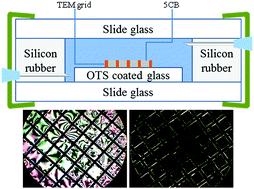Real-time liquid crystal-based biosensor for urea detection†
Abstract
A transmission electron microscopy (TEM) grid filled with 4-cyano-4′-pentylbiphenyl (5CB) on an octadecyltrichloro silane-coated glass substrate in aqueous media was developed to construct a urea biosensor by coating poly(acrylicacid-b-4-cyanobiphenyl-4-oxyundecylacrylate) (PAA-b-LCP) at the aqueous/5CB interface and immobilizing urease covalently to the PAA chains. Urea was detected from the planar to homeotropic (P–H) orientational transition of 5CB by polarized optical microscopy under crossed polarizers. This TEM grid sensor with the maximum immobilization density of urease, 0.17 molecules per nm2, enabled the detection of urea at concentrations as low as 5 mM through a P–H change with the half time of a full P–H change of 250 seconds. This TEM grid sensor could detect urea in the blood without any inference from hemoglobin and ascorbic acid. This new and sensitive urea biosensor is relatively inexpensive, allows easy naked eye detection, and may be useful for screening the urea level in the human body.


 Please wait while we load your content...
Please wait while we load your content...